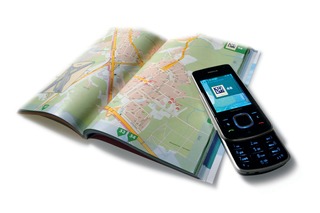The Combination of Printed and Online Media Opens up New Perspectives
There are many good arguments for the added value of print products in the entire media mix

It is the combination of new media and print products, more efficient production processes, and new opportunities for digital solutions in saddle stitching as well as softcover and hardcover production: at the drupa 2012, Muller Martini will show how innovative business models can help the graphic design industry be successful in the future.
“Video killed the radio star” sang British pop act ‘The Buggles’ in their number one hit 30 years ago. They were wrong though: motion pictures took nothing away from radio. “New media is killing print,” is what many pessimists are saying today. “They are wrong,” says Sture Udd. This Finnish media expert is not only the founder and CEO of UPC Print and CEO of UpCode Solutions Ltd. in Vaasa, Finland but also the inventor of UpCode – a system he refers to as “supermedia” that is now present in over 50 countries on the market.
“That is why print has a future!”
UpCode is a more ingenious way of mixing paper printed with a mobile phone than the normal QR code. Sture Udd’s prime example is a 300-page, perfectly bound street map of Moscow, which he produces for a Russian customer. Previously, the map was issued and sold in a print run of 30,000 copies, but, with more and more drivers turning to satellite navigation, the run decreased rapidly. To combat this, the publisher made some adjustments to the concept: The street map is now produced in a run of 150,000 copies and is available free of charge. It also features numerous pages with an UpCode that can be scanned by a cell phone camera, providing advertisements for sales campaigns at businesses based in the corresponding part of the city. The publisher’s printing costs for the street plan are covered by commission, which it receives every time an UpCode is accessed. This is possible because UpCode allows you to identify the print product from which it was accessed, and that is Sture Udd’s brilliant invention.
“Many customers who order catalogs and brochures operate based on cost per product,” explains Sture Udd, who has relied on finishing systems from Muller Martini for years now. “Unfortunately, many traditional advertisers and printers do not realize that working on a cost-per-order basis makes much more sense. I can use a mathematical formula to prove that printing an UpCode on brochures, promotional leaflets and flyers increases sales by 15 to 20 percent. “That is why print has a future!”
Print or online? – Print and online!
How graphics companies adapt to their coexistence with electronic media will also be crucial to their future success. Advertising has always relied on a media mix. In this regard, printed materials have enjoyed a long and successful history with excellent media efficiency rates. With a 35% share in print advertising, magazines and newspapers are still key players in the advertising market. The advertising industry keeps a watchful eye on the use of media content and pays good money to ensure that consumers are made aware of its products in the correct environment.
“Many of our customers are starting to use the printed media as an additional advertising channel,” says Markus F. Hof, CEO of the Direct Mail Company, the industry leader in Switzerland for the delivery of unaddressed advertising. According to a study, over 70% of German Internet shoppers get their ideas from a catalog. For this reason, DMC's successful strategy is built on a combination of paper and electronic media. For Markus F. Hof, the answer to the question “Print or online?”, is “Print and online!”
How Digital Printing Is Changing the World of Graphic Design
In addition to combinations of different media, new printing processes also bring completely new business models, in particular in digital printing, which has certainly changed the world of graphic design. The more efficient digital printing systems become, the more challenging the finishing process will be. Muller Martini responded to these new challenges with intelligent hybrid offset/digital systems for saddle stitching as well as softcover and hardcover production. These systems enable finishing businesses to be ready for the market demands of tomorrow.
Particularly attractive are the modern high-tech systems such as the digital book production system SigmaLine from Muller Martini, which the Courier Corporation in North Chelmsford, Massachusetts, the third largest book manufacturer in the United States, swears by. “The fact that we have commissioned three SigmaLine systems in a short time period is a clear indication that digital printing is gaining importance,” says Joseph L. Brennan, Vice President of Engineering at Courier Corporation. “We now have highly productive systems for the digital production of books in small print runs.” One main reason for deciding in favor of the SigmaLine was the Connex data and process management system developed by Muller Martini. Connex communicates with all the machines involved: it ensures high levels of safety and transparency during production, generates job data for all systems and facilitates the sorting, grouping and planning of orders. This is particularly important for increasingly small print runs.
Many New Opportunities
The positive economic effects of an intelligent link between digital printing and finishing can be seen at Webcom in Toronto. The BookFWDTM Program launched last year, in which both the Acoro A5 and the Bolero B9 perfect binders from Muller Martini, in addition to three digital printing presses, play an important role, helped to reduce costs for the Canadian company. “More efficient production processes enable our customers to increase savings throughout the entire supply chain – to an extent unparalleled in our industry,” says President and CEO of the company, Mike Collinge.
For Bruno Müller, CEO of Muller Martini, such examples clearly show that the graphic design industry is marketing its strengths more actively and systematically. “Even in the face of the increasingly common argument that print is threatened with extinction, there are also strong arguments in favor of the added value of print products in the entire media mix. I am convinced that print media has great development potential and offers the graphic design industry and advertising customers many new opportunities with innovative business ideas.”

